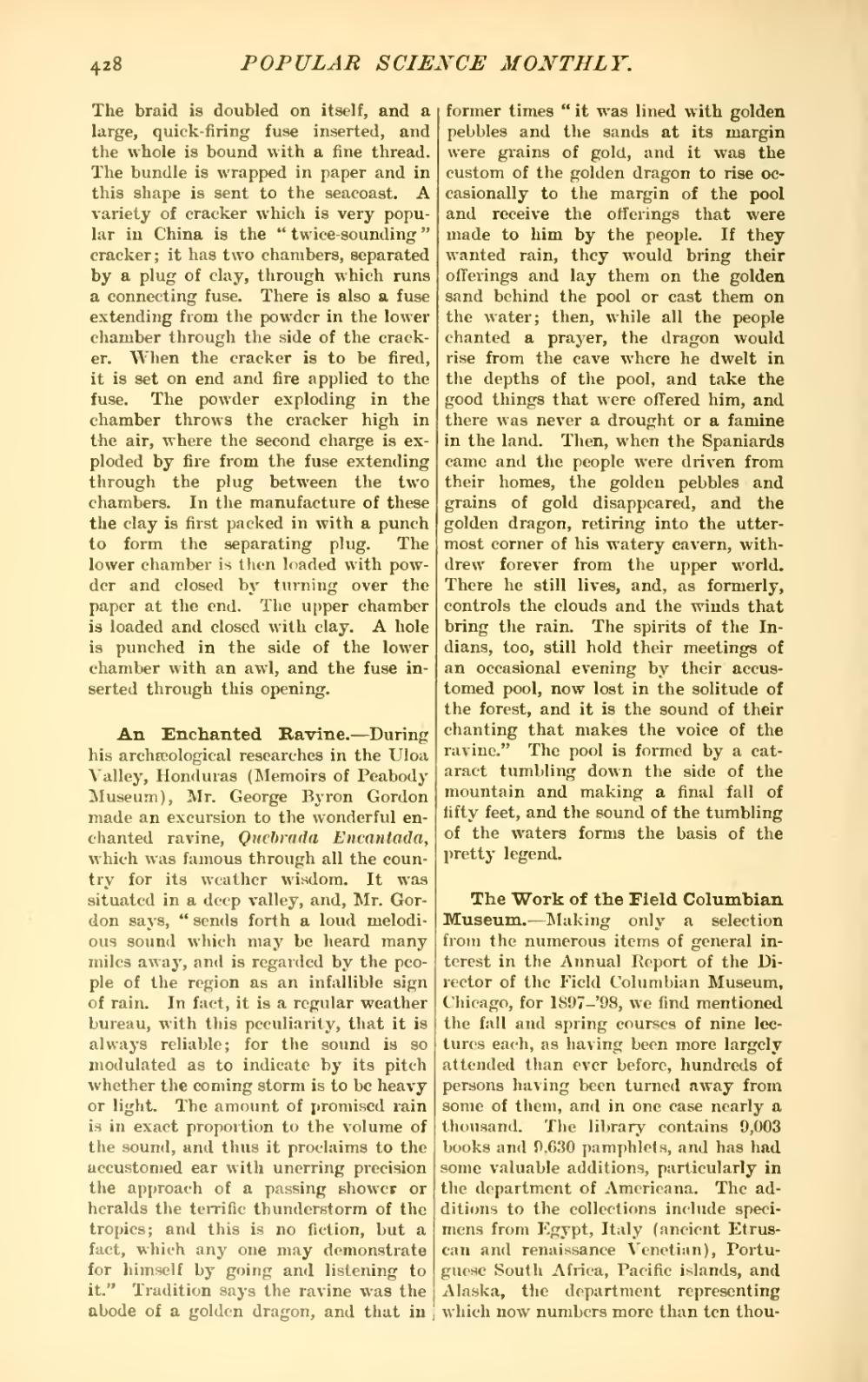The braid is doubled on itself, and a large, quick-firing fuse inserted, and the whole is bound with a fine thread. The bundle is wrapped in paper and in this shape is sent to the seacoast. A variety of cracker which is very popular in China is the "twice-sounding" cracker; it has two chambers, separated by a plug of clay, through which runs a connecting fuse. There is also a fuse extending from the powder in the lower chamber through the side of the cracker. When the cracker is to be fired, it is set on end and fire applied to the fuse. The powder exploding in the chamber throws the cracker high in the air, where the second charge is exploded by fire from the fuse extending through the plug between the two chambers. In the manufacture of these the clay is first packed in with a punch to form the separating plug. The lower chamber is then loaded with powder and closed by turning over the paper at the end. The upper chamber is loaded and closed with clay. A hole is punched in the side of the lower chamber with an awl, and the fuse inserted through this opening.
An Enchanted Ravine.—During his archæological researches in the Uloa Valley, Honduras (Memoirs of Peabody Museum), Mr. George Byron Gordon made an excursion to the wonderful enchanted ravine, Quchrada Encantada, which was famous through all the country for its weather wisdom. It was situated in a deep valley, and, Mr. Gordon says, "sends forth a loud melodious sound which may be heard many miles away, and is regarded by the people of the region as an infallible sign of rain. In fact, it is a regular weather bureau, with this peculiarity, that it is always reliable; for the sound is so modulated as to indicate by its pitch whether the coming storm is to be heavy or light. The amount of promised rain is in exact proportion to the volume of the sound, and thus it proclaims to the accustomed ear with unerring precision the approach of a passing shower or heralds the terrific thunderstorm of the tropics; and this is no fiction, but a fact, which any one may demonstrate for himself by going and listening to it." Tradition says the ravine was the abode of a golden dragon, and that in former times "it was lined with golden pebbles and the sands at its margin were grains of gold, and it was the custom of the golden dragon to rise occasionally to the margin of the pool and receive the offerings that were made to him by the people. If they wanted rain, they would bring their offerings and lay them on the golden sand behind the pool or cast them on the water; then, while all the people chanted a prayer, the dragon would rise from the cave where he dwelt in the depths of the pool, and take the good things that were offered him, and there was never a drought or a famine in the land. Then, when the Spaniards came and the people were driven from their homes, the golden pebbles and grains of gold disappeared, and the golden dragon, retiring into the uttermost corner of his watery cavern, withdrew forever from the upper world. There he still lives, and, as formerly, controls the clouds and the winds that bring the rain. The spirits of the Indians, too, still hold their meetings of an occasional evening by their accustomed pool, now lost in the solitude of the forest, and it is the sound of their chanting that makes the voice of the ravine." The pool is formed by a cataract tumbling down the side of the mountain and making a final fall of fifty feet, and the sound of the tumbling of the waters forms the basis of the pretty legend.
The Work of the Field Columbian Museum.—Making only a selection from the numerous items of general interest in the Annual Report of the Director of the Field Columbian Museum, Chicago, for 1897-'98, we find mentioned the fall and spring courses of nine lectures each, as having been more largely attended than ever before, hundreds of persons having been turned away from some of them, and in one case nearly a thousand. The library contains 9,003 books and 9,630 pamphlets, and has had some valuable additions, particularly in the department of Americana. The additions to the collections include specimens from Egypt, Italy (ancient Etruscan and renaissance Venetian), Portuguese South Africa, Pacific islands, and Alaska, the department representing which now numbers more than ten thou-
